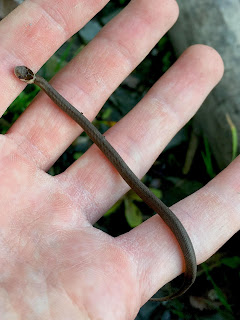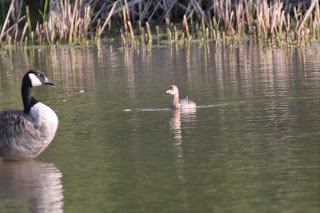Today was the
Charitable Big Day, which is a Big Day competition raising funds for Wildlife Preservation Canada. Teams got 12 hours between 8 am and 8 pm to find as many birds as possible. I teamed up with my friend Owen from Toronto. Since we are both high school students, and not able to drive to a place to bird together, we decided that he would bird in Toronto, and I would bird in London. At the end of the day we would put our species list together, and see what the outcome was.
The outcome was great!
There will be two parts to this post, the "London Report", which I am writing, and the "Toronto Report", which Owen is writing, which will be published soon.
Anyway, on with the London Report!
I started the day at one of my favourite local spots, Uplands Trail. Unfortunately, it was slower than I thought it would be, so the day started out average instead of the "bang" I was hoping for. The warbler count was 8, but that is nothing compared to the number of warblers Owen was seeing meanwhile in Toronto (I won't steal his thunder!) American Redstarts, Common Yellowthroat, Nashville Warbler, Black-throated Green, Black-throated Blue, Northern Parula, Cape May, and Wilson's added a bit of colour to the morning.
 |
| Wilson's |
 |
| Cape May |
 |
| Black-throated Green |
A few Ruby-throated Hummingbirds were buzzing around.
Thrushes were well represented this morning.
 |
| Swainson's |
 |
| American Robin |
I also managed to see an Olive-sided Flycatcher, however it was very brief.
I moved onto my next location, hoping to find a few more species for the day list. I had staked out Pied-billed Grebe and Blue-winged Teal, and I was hoping to catch up to them.
The Pied-billed Grebe was found right away.
Blue-winged Teal, Green-winged Teal, and Northern Shoveler followed suit.
 |
| Green-winged Teal |
There were a couple Green Herons that were moving throughout.
Two Solitary Sandpipers came in at one point.
I continued onto my next spot, where I found a kettle of Broad-winged Hawks and a few Turkey Vultures. A single Red-tailed Hawk was also found.
There were a number of Great Blue Herons seen throughout the day.
I went to Greenway Park in the early afternoon looking for shorebirds. Although I didn't find as many as I would have liked, Lesser Yellowlegs was added to the day list.
Also found was an Eastern Wood-Pewee, Rock Pigeons, and a trio of Indigo Buntings.
The Wonderland Drainage Ponds didn't yield any new birds for the cumulative day list, but I did find a Black-crowned Night-Heron, uncommon in Middlesex, and a Caspian Tern, new for my Middlesex list.
 |
| Black-crowned Night-Heron |
 |
| Caspian Tern |
Dingman Creek was next, but it was pretty disappointing. The only thing of note was a Least Flycatcher.
I spent the next couple hours at Westminster Ponds ESA. While it was pretty quiet, I added a few new birds to the list, including Hairy Woodpecker and Pileated Woodpecker. There were a couple other notable birds as well, such as Eastern Phoebe, Green Heron, and Magnolia Warbler.
 |
| Eastern Phoebe |
 |
| Magnolia Warbler |
Also present were a few Painted Turtles.
My last stop of the day was Killaly Meadows ESA. While I only added one new bird to the cumulative list here, I did it in a big way. While hiking on of the trails I looked up, and imagine my surprise and awe when I saw 50+ Common Nighthawks at the same time!
I, of course, left my camera in the car, so I tried my best digiscoping.
I ended the day with a respectable 75 species, which is better than I thought I'd do. I deem it a successful day! I can't wait to read what Owen's got to say!
Cumulative day list. Bold means that it was recorded only on the London list:
Canada Goose
Mute Swan
Trumpeter Swan
Hooded Merganser
Wood Duck
Gadwall
Blue-winged Teal
Northern Shoveler
Mallard
Green-winged Teal
Canvasback
Redhead
Common Merganser
Pied-billed Grebe
Double-crested Cormorant
Great Blue Heron
Great Egret
Green Heron
Black-crowned Night-Heron
Cooper’s Hawk
Northern Harrier
Turkey Vulture
Osprey
Bald Eagle
Broad-winged Hawk
Red-tailed Hawk
American Coot
Killdeer
Spotted Sandpiper
Solitary Sandpiper
Semipalmated Sandpiper
Greater Yellowlegs
Lesser Yellowlegs
Ring-billed Gull
Herring Gull
Caspian Tern
Rock Pigeon
Mourning Dove
Common Nighthawk
Ruby-throated Hummingbird
Belted Kingfisher
Yellow-bellied Sapsucker
Red-bellied Woodpecker
Downy Woodpecker
Hairy Woodpecker
Northern Flicker
Pileated Woodpecker
Olive-sided Flycatcher
Eastern Wood-Pewee
Yellow-bellied Flycatcher
Least Flycatcher
Eastern Phoebe
Philadelphia Vireo
Warbling Vireo
Red-eyed Vireo
Blue Jay
American Crow
Common Raven
Barn Swallow
Black-capped Chickadee
Red-breasted Nuthatch
House Wren
Winter Wren
Ruby-crowned Kinglet
Swainson's Thrush
American Robin
Gray Catbird
European Starling
Cedar Waxwing
Yellow-Rumped Warbler
Black-And-White Warbler
Nashville Warbler
Common Yellowthroat
American Redstart
Cape May Warbler
Northern Parula
Tennessee Warbler
Magnolia Warbler
Bay-Breasted Warbler
Blackburnian Warbler
Yellow Warbler
Chestnut-Sided Warbler
Blackpoll Warbler
Black-Throated Blue Warbler
Palm Warbler
Pine Warbler
Black-Throated Green Warbler
Canada Warbler
Wilson's Warbler
Clay-colored Sparrow
Lincoln’s Sparrow
Chipping Sparrow
Song Sparrow
Scarlet Tanager
Northern Cardinal
Rose-breasted Grosbeak
Indigo Bunting
Red-winged Blackbird
Brown-headed Cowbird
Common Grackle
House Finch
American Goldfinch
House Sparrow













































